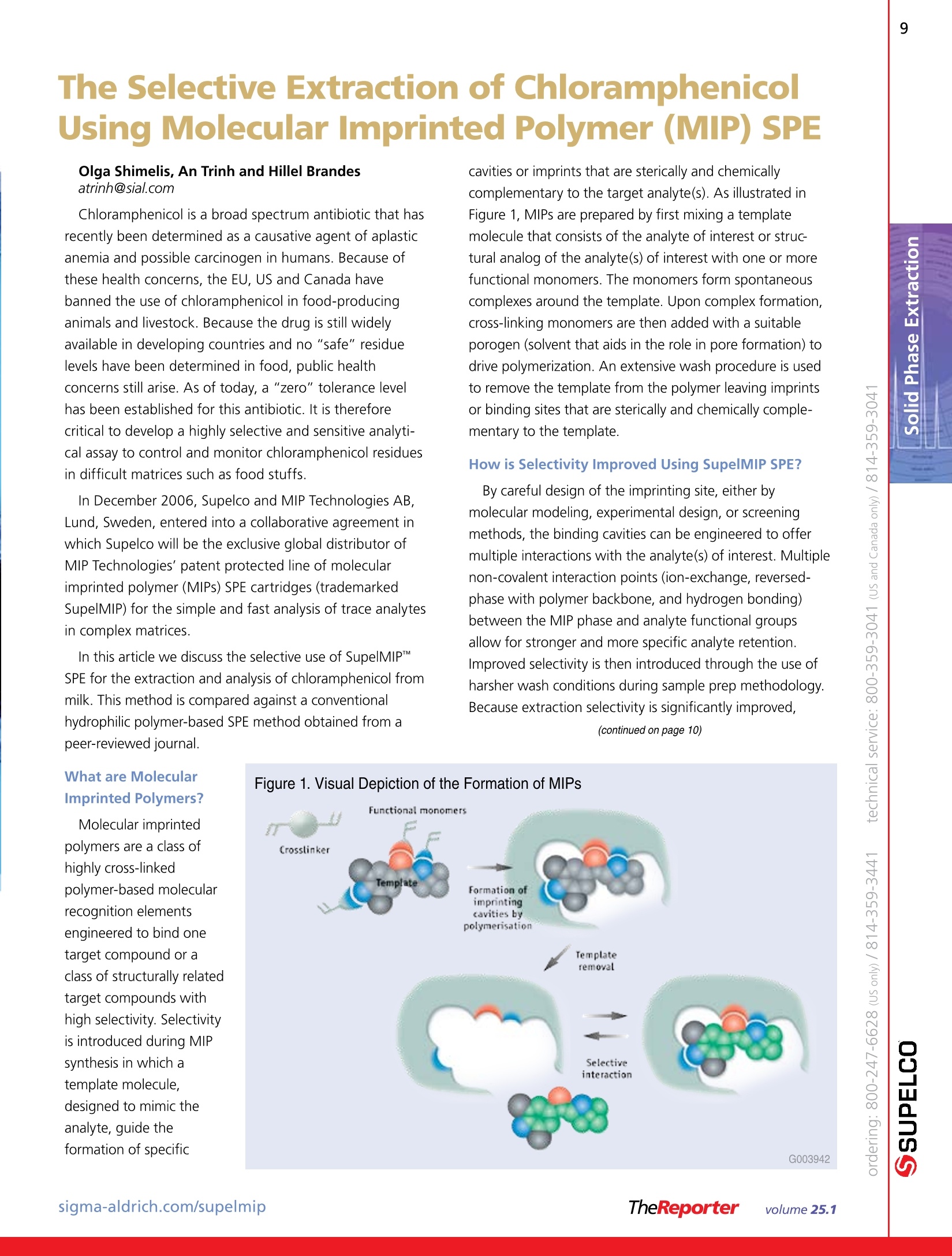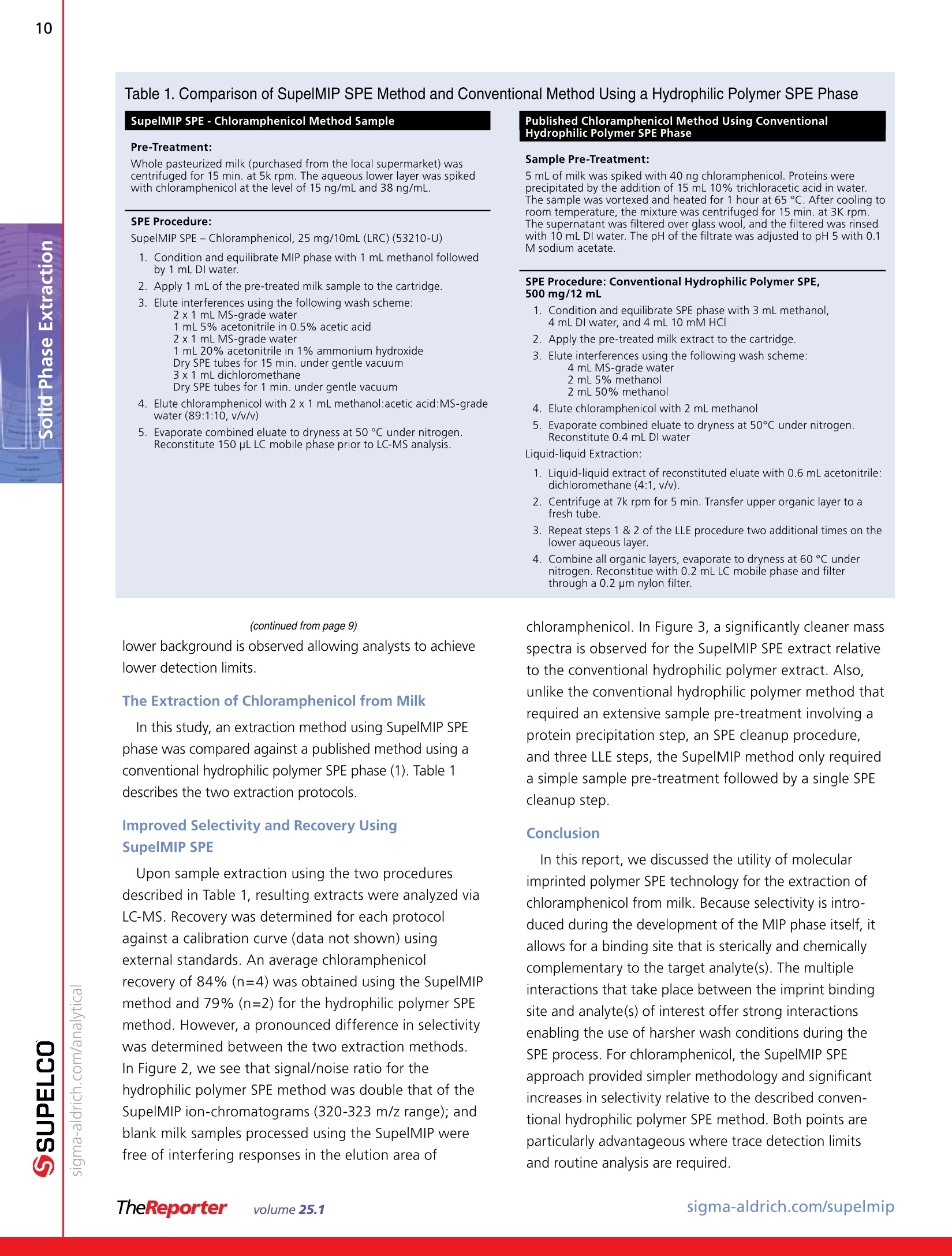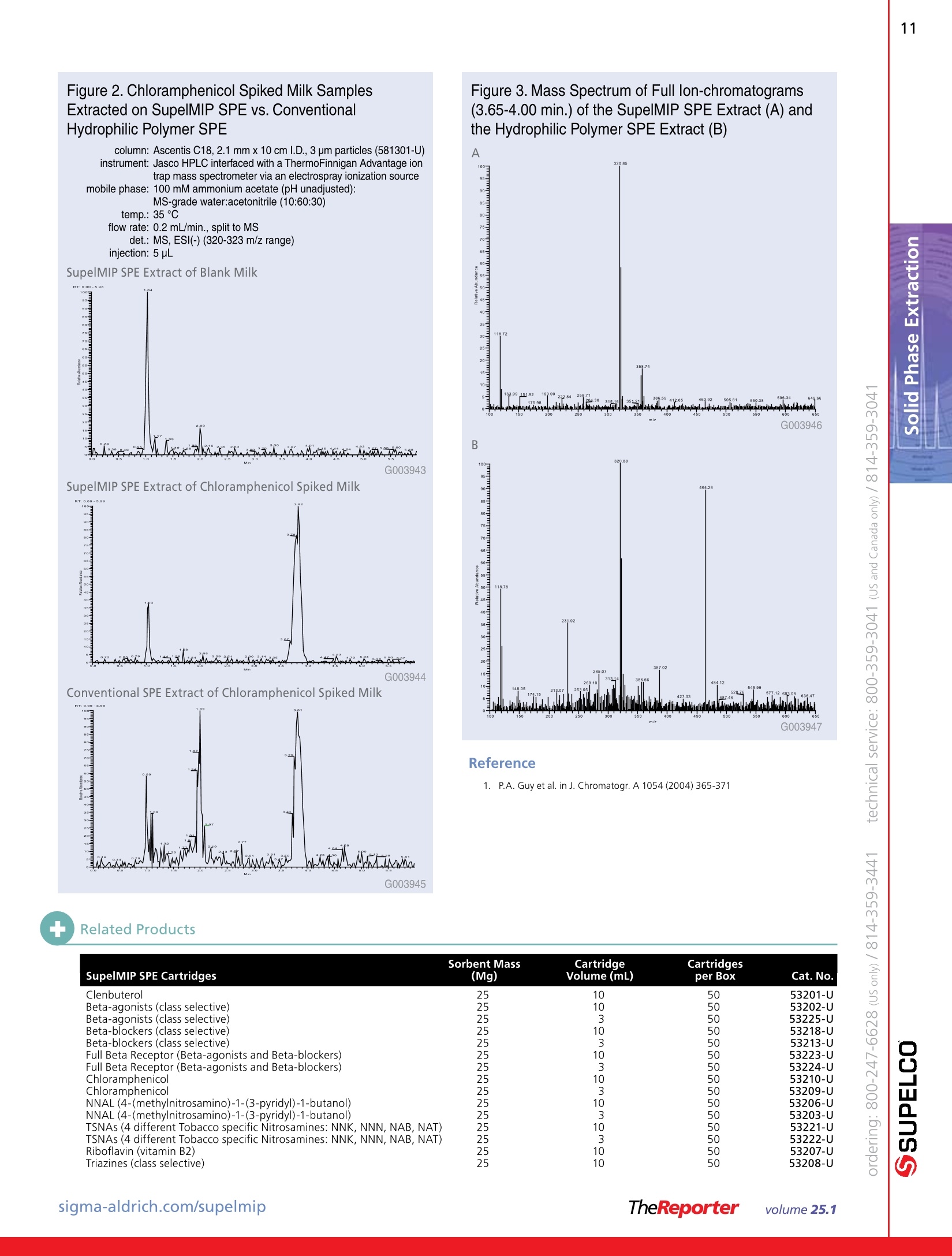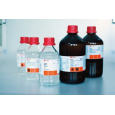
文章介绍了分子印记聚合物技术(MIP)的原理,同时对MIP小柱在提取牛奶中的氯霉素上的性能与传统聚合物基质的小柱进行了比较,结果表明,SupelMIP小柱有更高的选择性,更低的检测限,同时方法上更为简单,非常适合于痕量分析和日常常规分析。
方案详情

9 10Table 1. Comparison of SupelMIP SPE Method and Conventional Method Using a Hydrophilic Polymer SPE Phase The Selective Extraction of ChloramphenicolUsing Molecular Imprinted Polymer (MIP) SPE Olga Shimelis, An Trinh and Hillel Brandes atrinh@sial.com Chloramphenicol is a broad spectrum antibiotic that hasrecently been determined as a causative agent of aplasticanemia and possible carcinogen in humans. Because ofthese health concerns, the EU, US and Canada havebanned the use of chloramphenicol in food-producinganimals and livestock. Because the drug is still widelyavailable in developing countries and no "safe" residuelevels have been determined in food, public healthconcerns still arise. As of today, a"zero" tolerance levelhas been established for this antibiotic. It is thereforecritical to develop a highly selective and sensitive analyti-cal assay to control and monitor chloramphenicol residuesin difficult matrices such as food stuffs. In December 2006, Supelco and MIP Technologies AB,Lund, Sweden, entered into a collaborative agreement inwhich Supelco will be the exclusive global distributor ofMIP Technologies' patent protected line of molecularimprinted polymer (MIPs) SPE cartridges (trademarkedSupelMIP) for the simple and fast analysis of trace analytesin complex matrices. In this article we discuss the selective use of SupelMIP"SPE for the extraction and analysis of chloramphenicol frommilk. This method is compared against a conventionalhydrophilic polymer-based SPE method obtained from apeer-reviewed journal. cavities or imprints that are sterically and chemicallycomplementary to the target analyte(s). As illustrated inFigure 1, MIPs are prepared by first mixing a templatemolecule that consists of the analyte of interest or struc-tural analog of the analyte(s) of interest with one or morefunctional monomers. The monomers form spontaneouscomplexes around the template. Upon complex formation,cross-linking monomers are then added with a suitableporogen (solvent that aids in the role in pore formation) todrive polymerization. An extensive wash procedure is usedto remove the template from the polymer leaving imprintsor binding sites that are sterically and chemically comple-mentary to the template. How is Selectivity Improved Using SupelMIP SPE? By careful design of the imprinting site, either bymolecular modeling, experimental design, or screeningmethods, the binding cavities can be engineered to offermultiple interactions with the analyte(s) of interest. Multiplenon-covalent interaction points (ion-exchange, reversed-phase with polymer backbone, and hydrogen bonding)between the MIP phase and analyte functional groupsallow for stronger and more specific analyte retention.Improved selectivity is then introduced through the use ofharsher wash conditions during sample prep methodology.Because extraction selectivity is significantly improved, What are MolecularImprinted Polymers? Molecular imprintedpolymers are a class ofhighly cross-linkedpolymer-based molecularrecognition elementsengineered to bind onetarget compound or aclass of structurally relatedtarget compounds withhigh selectivity. Selectivityis introduced during MIPsynthesis in which atemplate molecule,designed to mimic theanalyte, guide theformation of specific Figure 1. Visual Depiction of the Formation of MIPs SupelMIP SPE -Chloramphenicol Method Sample Pre-Treatment: Whole pasteurized milk (purchased from the local supermarket) wascentrifuged for 15 min. at 5k rpm. The aqueous lower layer was spikedwith chloramphenicol at the level of 15 ng/mL and 38 ng/mL. SPE Procedure: SupelMIP SPE -Chloramphenicol, 25 mg/10mL(LRC) (53210-U) .1. Condition and equilibrate MIP phase with 1 mL methanol followedby 1 mL DI water. 2. Apply 1 mL of the pre-treated milk sample to the cartridge. 3. Elute interferences using the following wash scheme: 2x1 mL MS-grade water1 mL 5% acetonitrile in 0.5% acetic acid2 x 1 mL MS-grade water1 mL 20% acetonitrile in 1% ammonium hydroxideDry SPE tubes for 15 min. under gentle vacuum3 x 1 mL dichloromethane Dry SPE tubes for 1 min. under gentle vacuum 4. Elute chloramphenicol with 2x1 mL methanol:acetic acid:MS-gradewater (89:1:10,v/v/v) 5.Evaporate combined eluate to dryness at 50 °C under nitrogen.Reconstitute 150 pL LC mobile phase prior to LC-MS analysis. (continued from page 9) lower background is observed allowing analysts to achievelower detection limits. The Extraction of Chloramphenicol from Milk In this study, an extraction method using SupelMIP SPEphase was compared against a published method using aconventional hydrophilic polymer SPE phase (1). Table 1describes the two extraction protocols. Improved Selectivity and Recovery UsingSupelMIP SPE Upon sample extraction using the two proceduresdescribed in Table 1, resulting extracts were analyzed viaLC-MS. Recovery was determined for each protocolagainst a calibration curve (data not shown) usingexternal standards. An average chloramphenicolrecovery of 84%(n=4) was obtained using the SupelMIPmethod and 79%(n=2) for the hydrophilic polymer SPEmethod. However, a pronounced difference in selectivitywas determined between the two extraction methodsIn Figure 2, we see that signal/noise ratio for thehydrophilic polymer SPE method was double that of theSupelMIP ion-chromatograms (320-323 m/z range); andblank milk samples processed using the SupelMIP werefree of interfering responses in the elution area of Published Chloramphenicol Method Using ConventionalHydrophilic Polymer SPE Phase Sample Pre-Treatment: 5 mL of milk was spiked with 40 ng chloramphenicol. Proteins wereprecipitated by the addition of 15 mL 10% trichloracetic acid in water.The sample was vortexed and heated for 1 hour at 65C. After cooling toroom temperature, the mixture was centrifuged for 15 min. at 3K rpm.The supernatant was filtered over glass wool, and the filtered was rinsedwith 10 mL DI water. The pH of the filtrate was adjusted to pH 5 with 0.1M sodium acetate. SPE Procedure: Conventional Hydrophilic Polymer SPE,500 mg/12 mL 1. Condition and equilibrate SPE phase with 3 mL methanol,4 mL DI water, and 4 mL 10 mM HCI 2. Apply the pre-treated milk extract to the cartridge. 3. Elute interferences using the following wash scheme: 4 mL MS-grade water 2 mL 5% methanol 2 mL 50% methanol 4. Elute chloramphenicol with 2 mL methanol 5. EEvaporate combined eluate to dryness at 50℃ under nitrogen.Reconstitute 0.4mL DI waterLiquid-liquid Extraction: 1. Liquid-liquid extract of reconstituted eluate with 0.6 mL acetonitrile:dichloromethane(4:1,v/v). 2. Centrifuge at 7k rpm for 5 min. Transfer upper organic layer to afresh tube. 3. Repeat steps 1 & 2 of the LLE procedure two additional times on thelower aqueous layer. 4. Combine all organic layers, evaporate to dryness at 60 °C under nitrogen. Reconstitue with 0.2 mL LC mobile phase and filter through a 0.2 pm nylon filter. chloramphenicol. In Figure 3, a significantly cleaner massspectra is observed for the SupelMIP SPE extract relativeto the conventional hydrophilic polymer extract. Also,unlike the conventional hydrophilic polymer method thatrequired an extensive sample pre-treatment involving aprotein precipitation step, an SPE cleanup procedure,and three LLE steps, the SupelMIP method only requireda simple sample pre-treatment followed by a single SPEcleanup step. Conclusion In this report, we discussed the utility of molecularimprinted polymer SPE technology for the extraction ofchloramphenicol from milk. Because selectivity is intro-duced during the development of the MIP phase itself, itallows for a binding site that is sterically and chemicallycomplementary to the target analyte(s). The multipleinteractions that take place between the imprint bindingsite and analyte(s) of interest offer strong interactionsenabling the use of harsher wash conditions during theSPE process. For chloramphenicol, the SupelMIP SPEapproach provided simpler methodology and significantincreases in selectivity relative to the described conven-tional hydrophilic polymer SPE method. Both points areparticularly advantageous where trace detection limitsand routine analysis are required. Figure 2. Chloramphenicol Spiked Milk Samples Extracted on SupelMIP SPE vs. Conventional Hydrophilic Polymer SPE Figure 3. Mass Spectrum of Full lon-chromatograms(3.65-4.00 min.) of the SupelMIP SPE Extract (A) andthe Hydrophilic Polymer SPE Extract (B) column: Ascentis C18, 2.1 mmx 10 cm l.D., 3 pm particles (581301-U) instrument: Jasco HPLC interfaced with a ThermoFinnigan Advantage ion trap mass spectrometer via an electrospray ionization source mobile phase: 100 mM ammonium acetate (pH unadjusted): MS-grade water:acetonitrile (10:60:30) temp.: 35℃ flow rate: 0.2 mL/min., split to MS det.: MS, ESI(-) (320-323 m/z range) injection: 5 pL Conventional SPE Extract of Chloramphenicol Spiked Milk 、寸Omom寸occ寸OmOw1. P.A. Guy et al. in J. Chromatogr. A 1054 (2004) 365-371c Related Products TheReporter volume igma-aldrich.com/supelmip TheReporter volume igma-aldrich.com/supelmip
确定



还剩1页未读,是否继续阅读?
默克化工技术(上海)有限公司为您提供《乳制品及特殊膳食中农兽药残留检测方案 》,该方案主要用于乳粉中兽药残留检测,参考标准--,《乳制品及特殊膳食中农兽药残留检测方案 》用到的仪器有氯霉素 标准品、乙酸铵,MS级
相关方案
更多
该厂商其他方案
更多










